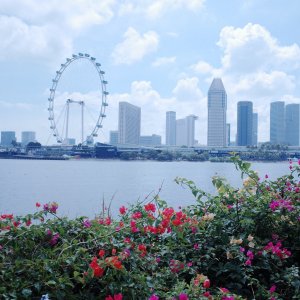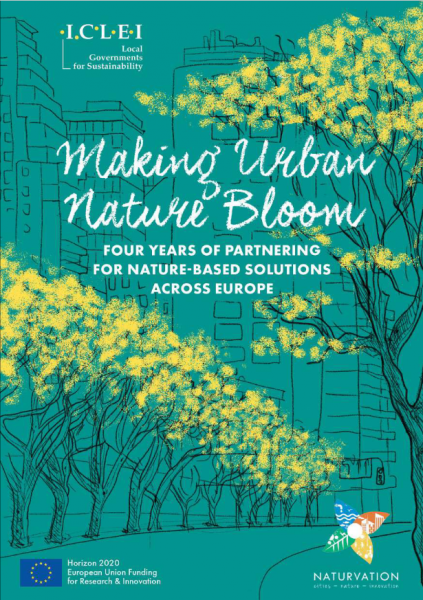
Nature-based solutions are an increasingly popular means for tackling urban sustainability challenges. Nonetheless, there’s no one-size-fits-all method for every city, even when we are dealing with the same topic. Here are a few points/tips/inspirational stories you could learn from when taking a journey of your own for a sustainable urban future.
Over four years, ICLEI Europe worked hand-in-hand with the NATURVATION project to create local partnerships in six European cities to advance the uptake of nature-based solutions locally, to discuss novel ways to integrate them as well as to forge new partnerships and (un)pave the way to make urban nature bloom. At the core of this work were the Urban-Regional Innovation Partnerships - six groups that went to great lengths to integrate nature-based solutions into local projects, plans and policies. Bringing together stakeholders from multiple sectors to engage in long, difficult discussions over a period of four years was not a simple task. Each partner city was dealing with different issues, but there were common threads, such as competing interests, stakeholder fatigue, inadequate representation, and of course COVID-19, which were major challenges throughout the process. The six local groups faced and overcame a myriad of challenges, but they also highlighted the vast potential and unique value of such partnerships, especially when it comes to developing innovative governance schemes and working beyond traditional organisational and knowledge boundaries.
As part of the urban-regional partnership process, ICLEI Europe together with other project partners, encouraged the six partner cities to examine their own nature-based solutions — some implemented during the course of the project. Their diverse cases highlight the potential for nature-based solutions to take hold across European cities, addressing core issues such as declining neighbourhoods, lack of funding for public spaces, and post-industrial transformation, as well as organisational challenges (knowledge, skill and governance gaps). The six examples that we showcase in the book share how the implementation of nature-based solutions builds on innovation and how each project adapts to its own unique governance and funding environment, including some reflections from project leaders and advice for other municipalities. Together, these groups brought diverse viewpoints from local authorities, researchers, civil society, practitioners, urban planners, and architects, truly demonstrating that nature-based solutions can be delivered by anyone. Despite the projects outlined in the book are from a European perspective, the lessons are global.
As such, engaging with such a diverse group of project stakeholders and partners brought us face-to-face with a major communication and collaboration challenge. How could we best work across the network of professionals and local partnerships, consisting of municipal representatives, urban developers, conservation organisations, community groups, and local businesses? To address such challenges, knowledge brokerage became, for instance, one of our key tasks throughout the project. This process of co-creating and re-framing knowledge involved creating novel ways to communicate and foster openness and flexibility to find creative ways of building bridges between the different communities of scholars and practitioners within and amongst the partnerships, having always transdisciplinarity in mind.
A clear lesson from the four years of partnership is the importance of locally anchoring stakeholder processes, and to tailor them to the needs and specificities of local actors and their context(s). This meant, among others, that new knowledge generated by the project had to be carefully translated and made accessible to the local groups, so that we could focus on local storylines, empowering each partnership to explicitly explore their needs and desires, by identifying their unique sustainability challenges, and to ultimately develop their own vision for mainstreaming nature-based solutions locally, as well as a roadmap for getting there.
Another core lesson is the centrality of cross-city knowledge exchange. During four years of the process, the partners from the six cities not only acted locally, but also engaged in ongoing peer learning. They were able to share examples of pioneer projects in their hometown and discuss potential cross-regional partnerships. Some cities saw similarities between themselves and other localities, leading to lively discussions about the implementation of nature-based solutions. This cross-pollination has led to long-term links and collaborations.
All in all, the work undertaken locally and among the six cities has helped to increase the capacity for more resilient and sustainable cities, fostering awareness of nature-based solutions and their potential to address pressing urban sustainability issues. Many local partners ended the project with plans for future interventions, and participants saw great value in communicating with local, subnational, and national authorities about the importance of nature-based solutions.
Curious about what these partnerships have built and sustained? More information on key features for constructive partnerships, innovative projects, insights and pathways for cities to mainstream nature-based solutions can be found in our recently published book entitled "Making Urban Nature Bloom - Four Years of Partnering for Nature-based Solutions Across Europe".
- Intza Balenciaga, Governance and Social innovation Officer, ICLEI Europe
< Access the book


